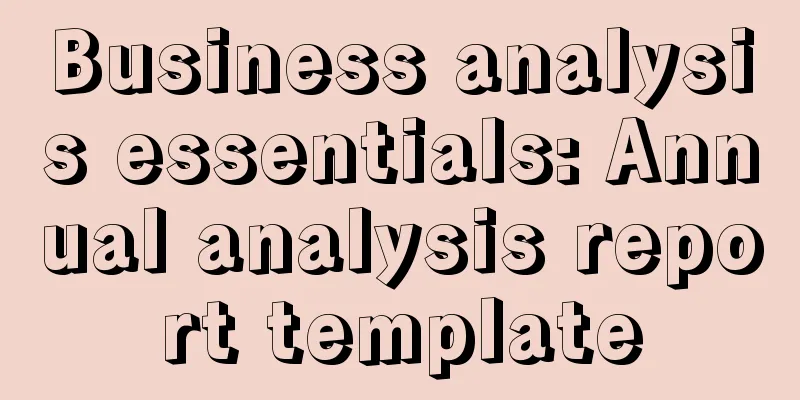Business analysis essentials: Annual analysis report template

As the end of the year approaches, many companies will organize the writing of annual analysis reports. This kind of big report is very stressful, and many students feel unsure and can't write high-quality content. Today, I will specifically share the annual report template and how to dig out key information. 1. Overall FrameworkThe annual report has fixed modules:
The most difficult part of the entire report is Part 5. Because the first part basically directly compares the actual situation with the annual target, and Parts 2, 3, and 4 are generally running accounts, breaking down income, costs, and expenses by various dimensions. If you do the first four parts mechanically and programmatically, you will be confused when you reach the fifth part: What is the conclusion? If you only say that indicator A is high and indicator B is low, your boss will definitely criticize you: "It's just a running account, no findings." The solution to the problem is to start from the first part, pay attention to summarizing the conclusions step by step, and deepen the analysis. 2. Key Indicator AnalysisKey indicators are generally revenue, gross profit, net profit, turnover and other main indicators. These main indicators have KPIs, so the results can be directly compared. But if you want to do it in depth, you can't just write high or low, but observe the situation of reaching the target and put forward analytical hypotheses. There are five common compliance situations and assumptions. You can write them down and draw conclusions based on your company’s data. The first step is to have a preliminary hypothesis, and the next step is to follow the map and go deeper. 3. Sales Revenue AnalysisSales analysis can be approached from three perspectives: people (customers), goods (products), and markets (channels). Remember not to make a cross-tab right away and write a bunch of "A meets the standard/B does not meet the standard" by customer/product/channel, as this will only confuse your thinking. If it is a traditional enterprise and the revenue/gross profit does not meet the requirements, the product structure should be considered first. Common problems include:
Therefore, we can start from the product perspective and identify the problem first (as shown below): After locating the problem, look at other angles. For example, if you have located that the A series products are lagging behind the overall market, you can further look at:
Internet companies are generally accustomed to approaching from the perspective of people, and can first stratify users (as shown in the following figure): Then look at:
In this way, we can narrow the scope step by step and get closer to the conclusion. IV. Cost AnalysisNote! Cost analysis must be linked to sales revenue analysis. This is because product positioning (hot items, traffic generation, profits) itself includes cost considerations, and expenses can directly stimulate revenue. Therefore, unless the cost control level of the enterprise manufacturing unit (cost center) is independently assessed, costs and revenue must be linked together. Here, we must first reclassify the nature of the expenses: Secondly, you can combine it with the fifth part to distinguish the cost input of major activities and look at the impact of major activities separately. Here are some common questions:
These questions echo the sales issues in the second part and can basically explain the problem clearly. V. Analysis of Important ActivitiesCommon important activities include: new product development and launch, major marketing activities, new channel construction, key customer group maintenance, etc. It should be noted that important activities are rarely reported until the end of the year. Generally, after the project starts, people can't wait to show their achievements to the boss. Therefore, it is very likely that the conclusions of the previous report will not match when reviewing at the end of the year. At this point, you must remember to look back at the report. If you really took credit and exaggerated at the time, then you must respond in the annual report. Explain why it looks good in the short term, but not in the long term. It is possible that the short-term effect is aimed at the local optimal solution. It may not be the best choice in the long run. So don't worry about being criticized, just explain it clearly. 6. Main issues and experiencesThrough steps 1 to 4, we are actually getting closer and closer to the answer to the question. You can check the summary of each chapter of your report. If the summary is as shown below, it is easy to get the answer by advancing layer by layer. But! When you reach the last step, you have to stop. Because there is a key question: "Who is to blame for this outcome?" There is no conclusion yet. There are three common attribution methods (as shown below). The conclusion of the annual analysis report greatly affects the boss's view of each department, so be careful when making attributions! If you can't make a decision, just ask your leader! The above is the basic framework of the annual report. There is also the last part: future prospects. Some companies have done it separately in the 2024 annual plan, and only give a qualitative description in the annual report. Author: Down-to-earth Teacher Chen WeChat public account: Down-to-earth Teacher Chen |
<<: How seductive is “anthropomorphic” copywriting?
>>: Entering commercialization 2.0, is Video Account still the last traffic pool?
Recommend
Fans surge! WeChat "Ask a question", a must-do traffic outlet in 2023
WeChat has added a new section called "Ask a ...
Is Wish's no-source model a scam? Is it reliable?
Now many friends want to open a store. Compared wi...
Which is the best at “Spring Festival Marketing”? Here is a summary of the best strategies for all platforms!
The Spring Festival has not yet arrived, but marke...
What problem should the brand solve?
Brand is not only a bridge between enterprises and...
The inside story of JD.com's 10 billion yuan subsidy: 1 hour of secret training, free shipping for 9.9 yuan, the first shot will be fired on March 1
The news that JD.com will launch a "10 billio...
How many days does Shopee set for delivery? What are the delivery channels?
After we open a store on Shopee, we need to ship t...
Unveiling the quotes of AI digital humans: Can you make money from the quotes of the Douyin AI little monk and old man?
What is AI digital human quotes? How to produce AI...
Do I need a business license to open a cross-border e-commerce store? How do I apply for one?
Cross-border e-commerce can be said to be the hott...
How can the marketing customer acquisition team be data-driven?
How can the marketing customer acquisition team be...
Lululemon is not selling well anymore, will Arc’teryx be the next?
The decline in lululemon's stock price and the...
Is Lazada's average order value high? How does it make money?
I believe that all of you who run online stores sh...
There are no winners in the drinking water price war
This summer, Nongfu Spring ignited a price war in ...
What is the cost of thc? What is the charging standard?
Everyone knows that when buying and selling goods ...
Self-assessment of corporate customer acquisition capabilities: What level is your company at?
In this article, the author shares several typical...
Achieving growth against the trend amid internal and external troubles: Bosideng "renews the old brand"
The times are developing rapidly, and traditional ...









